Italian aircraft carrier Cavour has returned to Taranto naval base in Italy after three months of operations with U.S. military in the Atlantic Ocean.
Cavour participated in a series of tests and functional activities, following which the F-35 Joint Program Office has delivered a flight clearance recommendation to the Italian Navy for the safe operation of fifth-generation F-35B fighter aircraft.
“During the sea trials, two F-35Bs were embarked aboard Cavour and carried out more than 50 flight missions, around 120 vertical landings, 115 short take-offs, and two vertical takeoffs. The Italian Navy Cavour aircraft carrier is now fully qualified to conduct operational deployment with the fifth-generation fighter F-35B. While operating in the western Atlantic, ITS Cavour collaborated with the Arleigh Burke-class guided-missile destroyer USS Stout (DDG 55). They conducted a three-day interoperability exercise with support from Carrier Air Wing (CVW) 7 and Patrol and Reconnaissance Wing (CPRW) 11.
ITS Cavour also conducted dual-carrier operations alongside USS Gerald R. Ford (CVN 78), marking the first time a Gerald R. Ford-class and Italian carrier operated jointly. For decades, the bond between Europe and North America has made NATO the strongest Alliance in history. Conducting training and exercises alongside Allies and partners increases our collective capacity and capabilities as well as increased interoperability with the U.S. forces. Its Cavour has truly been an ambassador of this trans-Atlantic bond.”
NATO add here that several Allied carrier strike groups, under national command, will be deployed into SACEUR Area of Responsibility (AOR) in the upcoming weeks and months.
“These multiple deployments demonstrate the Allied commitment to the maritime enterprise as well as our ability to effectively deliver multi-domain effects.”


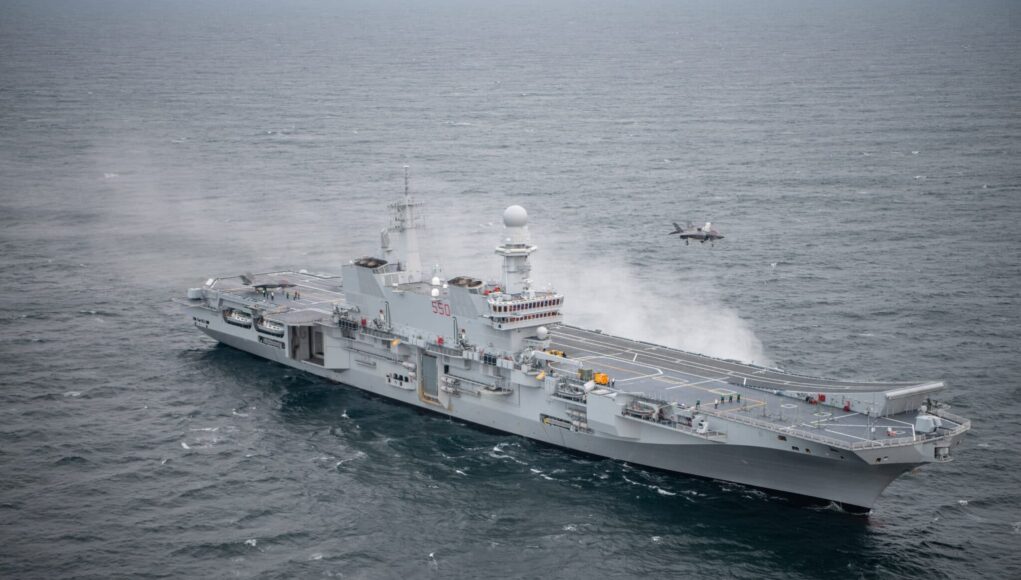
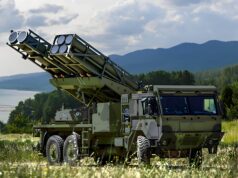

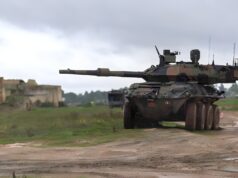
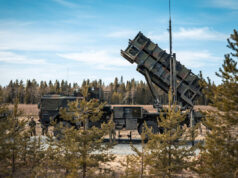
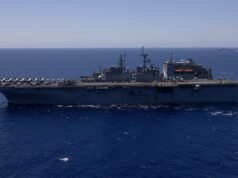
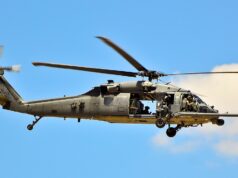
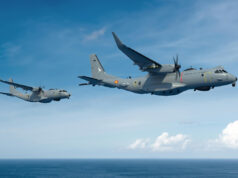


I like Cavour, she’s a much needed step up from Guiseppe Garibaldi, and seems like a decent little carrier in her own right. Hopefully between her, GG and Trieste the Marina Militare can also maintain a CSG at readyness.
Given the likely numbers of F35s UK will be able to deploy, smaller versatile carriers like the Trieste might have been a better choice. Certainly much cheaper at £1b.
You do understand that Trieste wouldn’t have been able to embark the current airgroup on HMS Queen Elizabeth right? Just the 10 Merlins would already be close to the limit of Triestes airgroup.
Yes max of 10F35. If we are stuck at 48 for several years after 2025, we will only be able to embark @12 on each carrier unless we keep on borrowing USMC aircraft.
I think Italy has been more realistic in its procurement decisions: both Cavour and Trieste have been well equipped with defensive systems. QE class are virtually unarmed. They are just the latest and biggest example of fitted for but not with because budgets don’t match the ambition.
Unlike Cavour or Trieste, QE has only one role- to carry aircraft. Doing this with such small numbers is embarrassing.
We’re keeping QE for 50 years at present plans, just because it’s IOC is 28 aircraft (still higher than Triestes) doesn’t mean it always will be. On this first deployment the Airwing on QE is 28 aircraft, Trieste and Cavour combined will only just beat that, and when in the 2030’s the UK has 60, 70, or more F35s, we would have unnecessarily have knobbled our Carrier airwings for the sake of “more efficient use” during the IOC period.
QE class are indeed virtually unarmed, this is in large part because the QE and Cavour are designed for very different operating environments. QE is a Blue Water fleet carrier designed to deploy globally with a large task force. Trieste is an LHD designed to go close inshore and Cavour is a light carrier designed primarily to operate in the confined waters of the Med. These carry different design requirements.
Nothing embarrasing, it’s a capability that will take time to build up, and at it’s initial operating capacity with 1 carrier already exceeds the ability of the Italian Navy. What’s embarrasing is the lack of ambition that would have resulted in effecitvely another round of very limited Illustrious class light carriers.
Again, never mind the F35’s, the Merlins alone would be making Trieste or Cavour a crowded place. BTW 10 F-35 is the limit of Cavours airgroup, Trieste’s upper limit is 12 Merlin which means much less than 10 F-35s.
Just to note:
The airwing is 25, not 28 (18 F35, 7 Merlin). The additional 3 merlin cabs are embarked on Fort Vic.
Of course QE can carry more aircraft- it has twice the displacement and cost 3.5x as much. And that’s the point: so much has been spent on the carriers ( more than double the original budget) that we now cannot afford to use them fully. It is unlikely we ever will.
To me, embarking just 8 UK jets 4 years after the ship was commissioned is embarrassing.
Despite all the recent spin, the original plan was to have 138 F35s, allowing each carrier to operate 24 and surge to 36. It was never the aim to spread orders for 138 over 50 years.
Again, IOC. You seem to have real trouble understanding that. And as much as you might scoff at the USMC deployment, that deployment would be impossible if we had a Trieste instead of a QE because she’d be full. You’d rather give up on ever having growth potential. 36 Planes remains a surge capacity on the carrier even if only 48 where purchesed (the number is going to be much higher than that). Do you know how many F-35s the Italian Navy is buying? 15. In total. That’s how small the airwing they intend to operate is. At any rate we still plan on having well north of 48 so, even though the plan never was to deploy both carriers at the same time, and instead be able to have one available at all times (funny how your memory of plans is so selective), no problem.
*Edit* And you are completely right, it was never the aim to spread the orders for 138 over 50 years, and it isn’t the plan to spread the orders for F-35 (whatever the final number is) over 50 years now.
However the plan is for QE to be in service for 50 years, and if in 40 years we decide we want to operate something other than F-35 wouldn’t we look like tits if we could only buy 20 of them because we’d bought two itty bitty carriers than can’t work with more.
I think we look like t**s for having commissioned 2 ships we can’t afford to equip.
To avoid the embarrassment of admitting we aren’t going to buy the planned 138 any time soon, MOD and RN
spokesmen have “clarified” that number as over the whole service life to 2060.
The initial aim was to replace RAF Harriers and Tornadoes with F35, an expansion of the joint force Harrier concept. It is therefore obvious that the plan to buy 138 was not to be spread over 40+ years. To give the RAF a proper replacement fleet of strike aircraft and the RN enough to have a minimum effective force on each carrier( non surge) the 138 would need to be in service at the same time.
The RAF has lost @ half of its combat jet fleet over the last few years. There is little prospect of improvement until Tempest arrives in the late 2030s.
Overall, the price paid to have 2 large carriers capable of operating just one super expensive combat aircraft type has been a disastrous weakening of our overall defence capacity.
Whilst debating absolute numbers, it’s also important to remember the production rate of F35s. They don’t come off the production line in squadron type numbers so any air capability would build slowly
Peter S, you do seem to get “embarrassed” very easily. Just sayin’…..
Ha ha! Not embarrassed personally of course but genuinely concerned at how feeble our effort looks compared say with Ark Royals aircraft complement in 1970.
We simply can’t do global presence on the money available.
Looks weak in comparison yes but capabilities of both airframes and platforms improved substantially. I would still rather have a smaller airwing on the QE than a load of phantoms and buccaneers, flying about as heavy metal targets to todays F35. We can all hark to the old days but things change, not always for the better (in some opinions) but that’s where we are, and as usual, the military will play to its strengths and mitigate its weaknesses no matter what asset or equipment we are talking about. Cheers.
You could then aspire to be the Hellenic Airforce and still operate F-4’s. But I suspect that would be even more “embarrasing”.
To save you feeling so embarrassed and looking like a t** (your ascribed feelings – not my determination), perhaps you might take into consideration a few reasons why the UK is not making firm commitments to all 138 F35s.
1) The world has moved on from when F-35 was defined some 2 decades ago. The UK now has the Tempest program that will deliver both a more advanced platform than F-35, almost certainly better suited to long range missions for the RAF than F-35A can offer, and unmanned loyal wing-man assets. Both of those developments would eliminate any prospective F-35A requirement that might have been originally envisaged for the RAF and create an RAF manned/unmanned structure unthinkable when F-35 purchase plans were made.
2) The F-35 is not as low cost to procure or operate as originally envisaged. Conversely there is a major focus on cost structure for Tempest by both BAE and the RAF, in order to get numbers up. So there may not be much of a premium for Tempest over F-35.
3) Major UK industrial and intellectual property value of the Tempest program that dwarfs the financial benefits of F-35 manufacturing participation. Conversely, no commercial or political benefit in stating that the UK will now procure less than 138 F-35 through the program. Indeed with the long life of the carriers, its entirely possible that additional F-35Bs will be bought beyond the 70-80 currently suggested, because it will make financial sense to buy new rather than pay high upgrade costs on existing platforms. We’ve already seen the UK suggest they won’t update the earliest aircraft.
Half full, could you tell me how many tempest you imagine being placed on the decks of the QE or POW?
Oh, none? And the f35B buy was really for the carriers, right?
Oh, so you bought two fancy carriers and ditched its planes for your new fancy land based jet, that hasn’t left the drawing board, got it. Just making sure we’re on the same page.
Call it what you want, the RN was decimated at the expense of the RAF on this whole f35 < tempeste situation. Apples and oranges lads.
No we’re not on the same page John.
When the UK committed to F35 it was the only game in town with its capabilities. It was destined for both RAF and FAA. The purchase might have been all F35B or it might have included F35A for the RAF, but that was the extent of the choice. Now the RAF has another choice in that class of capability or better, a Tempest manned platform.
That doesn’t mean the FAA and the carriers lose F35B. We are committed to more than 48 F35B, we may end up with 70-80 by the mid-30’s. Up to that point the force will be shared between RAF and FAA. After that point the RAF will increasingly focus on Tempest as its numbers ramp along with existing Typhoon manned platforms, while the FAA get the F35B. The RAF may still see a need for VSTOL in their role, but I think it unlikely.
As to the whole RN vs RAF thing. Its ridiculous and immature. Forces in general are increasing operating integrated. But people love to make up conflict and competition where there isn’t any.
Let’s speak truths…. for now the commitment is 48 over the life of the program… meaning not an active fleet of 48 at any point in time and certainly not anytime soon… however, the UK needs them asap to be capable of fully fitting both carriers.
The tempeste choice hurts the navy because without it, the navy would have its jets.
Let’s be honest, now the UK will never be capable of fitting both carriers fully with jets without the usmc filling the void.
The more likely outcome will be that one of the carriers is parked much of the time or when they coexist in operations they have a heavier mix of helos. A mix dictated and not chosen.
I also have very little faith in the commitment of f35s being increased “one day”. It’s an easy thing for a politician to say when they know they won’t be in office or having to make the budget work when that decision comes. But it sure makes the bad news easier to deliver in the moment.
Not sure what truths you’re referencing, perhaps you have a link? The current order is for 48, the Defence in a Competitive Age document released in March 2020 states –
“The Royal Air Force will continue to grow its Combat Air capacity over the next few years as we fully establish all seven operational Typhoon Squadrons and grow the Lightning II Force, increasing the fleet size beyond the 48 aircraft that we have already ordered.”
https://www.gov.uk/government/publications/defence-in-a-competitive-age
No one has stated that 48 is the commitment over the life of the program.
There was never an intent to routinely operate both carriers at the same time, because its not sustainable to do so with two vessels.
There is a lot of debate on the issue of QE class. You need to consider a few things around the programme.
The cost per ship was needlessly increased by David Cameron’s idiotic government delaying the programme by 2 years to review design for CATOBAR equipped carriers. The cost of these late design changes and time delays added over 750 million to both ships.
The QE class is without doubt the most efficient designed full sized carrier yet produced.
They offer the benefit of big deck operations in terms of efficient aircraft handling, sortie rate generation and hangar space at the lowest possible price. If for example in 2023 a QE class with 24 uk F35Bs onboard+ 12 US marine corps F35Bs+ 8-10 merlins with a crew compliment of just 1650 personnel. The QE would generate a sortie rate of upto 300 missions per day. A smaller decked carrier like Cavour even if in company with Trieste, working together couldnt hope to bring that much air activity to bear. Possibly 150 sorties as a max together vs easily 300 for a QE.
So sortie rate, big deck efficiency. Low personnel numbers all equals an amazing ship.
If into the 2030s the UK has got upto 70-80 F35Bs that will be adequate. The RAF will have Eurofighter typhoon and Tempest with loyal wingman drones and uk plc fast air both Fleet air arm and RAF will be going somewhere.
Great point. Also reminds the disaster of not installing the cats will be. By not installing the cats, the f35b became a must, and then the decision was to short the f35b…. wow.
At least with the cats it’d have been possible to imagine future aircraft on the deck.
I agree. The decision to build carriers to operate the F35 was a logical one at the time, building on our experience of the Harrier. But it has locked us into a single aircraft in whose development we participate but with no control of the overall programme.
So the only alternative now is to retro fit an EMAL system. The specifications in the recent RN request for proposals would seem to fall short of allowing us to operate other manned aircraft.To incur the disruption and costs of EMAL without ensuring we could operate other manned jets would be a mistake. Do it properly or not at all.
In addition to the negative impact the carrier/F35 programme has had on our ability to fund other needed equipment, there is a further concern. Defence has been seen as an easy option for cuts by successive governments. Massive cost overruns in such a big project play into the hands of those critics who would spend even less on defence.
You really are reaching with your arguments, “…we now cannot afford to use them fully. It is unlikely we ever will.”
The carriers have a 50 year life, but you’re certain you know we won’t be able to afford them over the course of the next half century.
No one can be certain about the next 50 years. But I think it is a reasonable expectation that manned aircraft will never be afforded in sufficient numbers to utilise the full designed capacity of 2 carriers.
It is possible that UCAVs could mitigate the shortage ( which is why the RN is looking at EMALS).
I am not hostile to carriers, unlike Max Hastings. I just feel we have been too ambitious and that the problems that has caused were largely predictable.
illustrious class were limited but show there could punch there weight like back in 82 Falklands conflict sure cavours would do well been bigger and hold her own .But there again when we Brits are in a fight we do punch above our weight could the Italians ?.
If you mean could the Italian Navy have retaken the Falklands in 82? (Sorry, I don’t mean to be rude Andrew but I’m struggling to follow your post). No I don’t think they could. Even the 40 odd Harriers the RN had then would be a bit beyond the current Italian Navy (assuming Trieste has replaced Guiseppe), but also the Italian Navy simple isn’t now, nor has it ever been set up for operations in the south Atlantic. It’s focus is squarely on the Med, and global projection is not high on it’s priority list.
Not at all Dern ,just saying think the Italian carrier although smaller then the QEs still capable ship compare to our 80s carriers .Enjoy reading your posts 😀.
Thank you. Yeah, as I said I think Cavour is a handy carrier, and will serve the Italians well, I just don’t think it’s a good shout for what the RN needs. 😀
We only had 20 odd involved in the conflict.
You’re forgetting the GR.3s
16 Sea Harriers on Hermes,
7 Sea Harriers on Invincible
10 GR.3’s on Hermes (okay sue me I rounded up).
You might just be able to squeeze that onto Trieste and Cavour, but you’d need to find somewhere else to put the Sea Kings.
I don’t think anyone is going to compare the RN with the Italian navy, as its clear which is better overall geared, but if pushed im sure you could put the helicopters somewhere.
Let’s say we had the trieste and covour in the RN in 2021 minus the QEs, you could then put the merlins / wildcats/apache spread across the frigates/destroyers/bay/albion/argus and pushed the River2. Not ideal, but very little about the logistics of the falklands was ideal.
You would clearly prefer a QE, but it could be done if extreme happened.
However its false econonmy as there is zero chance that the government would have instead spent the savings on more escorts etc, they would have just pocketed the difference and spent elsewhere, such as on their pub landlord.
You’re right, it is clear which one is better geared:
If you want a Navy that’s set up to operate close to home in confiend Waters the MM is better geared.
If you want an Ocean Going navy that deploys around the world the RN is better geared.
Well, you won’t want to put Apache on Escorts since they aren’t navalised, putting them on a big carrier is bad enough.
Bays and Albions don’t have Hangars so anything landing on them is temporary and in small numbers. Rivers can take one Helicopter for a very small period of time and do not belong in a combat zone, and then you factor in that most escorts are already carring Helicotpers. Look at CSG 21: Of the 6 Escorts, the 4 RN ones are carrying a Wildcat each, and the KM one is carrying an NH90, only USS The Sullivans isn’t carrying a helicopter and she doesn’t have a hangar.
So replacing QE with a Cavour/Trieste combo, for the RN, can’t be compensated for simply by offloading the Helicopters onto the escorts because that requires more escorts (and therefore reduction of other tasks). Same applies for the Falklands, most Escorts that could embark a Helicopter already had one embarked.
If it comes to it, we would send everything we had, and if that means Apache risk getting rusty then I doubt anyone would care. Very much like they did during the libya war, when it came clear the tornadoes alone couldn’t do the job
It wouldn’t get “rusty” it would be “inoperable” and there’s a world of difference between having an Apache Regiment embarked on a platform like HMS Ocean, with all of it’s maintenance crews and supplies on board, to having them spread about the fleet on escorts platforms.
And that’s not touching the fact that you’d have to then find somewhere for the Wildcats that are embarked on the Escorts (I’m sure any RN captain would prefer to have a significant part of their ASW system on board than an rapidly inoperable airframe that’s designed to support ground troops).
For sure, but we are not taking every day missions we are taking war where less than ideal but it works, has to be priorities over ideal. Maintainance wise I doubt it would be a big difference, as you could fly them in and out of the vessels with the better faculties. Don’t forget Atlantic conveyor was hastily setup to be a carrier, although as it sits at the bottom of the ocean we will never know how effective or otherwise it would have been.
Well you wouldn’t be able to fly the Apaches over to the carrier for maintenance because, if it was Trieste and Cavour, they’d be a full with their own airwings, there would be no space for that, and again, where would the Wildcats go that you have displaced? So yes, it would be a big difference.
And yes, it has to be priorities over ideal, which is why any RN commander will choose a helicopter that is actually designed to work at sea, and is part of his ASW team than a ground support asset for troops ashore.
Now you’re mixing your scenarios:
If we are talking about the 2021 RN with Cavour and Trieste instead of the QE’s then Atlantic Conveyor shouldn’t be entering into the equation, but if you actually must bring that in: It’s worth pointing out that if you had QE’s you wouldn’t need Atlantic Conveyor because you’d have enough space on the two carriers, hence no need to jury rig another carrier (and the fact that she is on the bottom of the ocean is a good indication of how well that particular idea went).
Not sure where you got that info from. During Falklands war 28 of the UK’s available 32 sea harriers were deployed. That was reported by Nott (defence minister at the time) to parliament.
That’s beccause GR.3’s are not Sea Harriers. Like Steve your numbers don’t include the RAF (not Sea) Harriers.
Hi Steve
The maximum number of Harriers deployed in the Falklands conflict during a single day was on 20 May 1982 (on the eve of the San Carlos landings) – 31 airframes.
25 FAA Sea Harriers: Nos 800, 801, 899 squadrons.
6 RAF Harrier GR3s: No.1 squadron.
21 on Hermes (including the GR3s), and 10 on Invincible.
Another 4 GR3s were later sent to Hermes as attrition replacements.
Spot on well said.
Yes quite right the QE class is an investment in the future Blue Water RN. These are a strategic asset. The Italian carrier is a great small carrier but she is more suited for the Med.
You don’t seem to understand the strategic value of being able to deploy with USMC F35B. Value for both the UK and the US.
It is likely to remain a capability through the life of the carriers, regardless of how many F35Bs we procure, because it creates uncertainty for adversaries about the weight of deployable carrier air power in Europe, the Middle East and Asia. Its not just how much is deployable from UK carriers, but also where else US carriers might operate because UK carriers can be deployed with 30-40+ F35B. Thus a UK carrier might replace a US carrier in one location, freeing it up to enable its deployment in another.
Uncertainty = deterrence.
We should not be dependant on the US to ensure our capabilty – how is that a sovreign Navy.
If our long term strategy requires the USMC to provide capabilty that makes a mockery of the procurment decisions and of the independance of the UK and its forces.
We aren’t. But we work together with Allies to mitigate our weaknesses and play to our strengths. Far to much moaning about “we have to rely on allies” etc, a very common civvy trait I have found (with all due respect). We can never have enough of everything we want or would like,. therefore we have Allies. People, tribes, city states, communities and Armies have been working together since man first picked up a weapon. Its nothing new.
.
To add to Airborne’s response. The UK has pretty much always worked with allies. Even with the Falklands conflict, allies took actions that helped enable UK success. That like minded countries ally together to the degree that they do is a strength not a weakness.
Relying on the US to hide gaps in capability is concerning, but the armed forces have shrunk so much at this point that the UK going it alone is now almost impossible, so whether its with the US or another ally, we will have another ally to cover the gaps.
For me the main reason its concerning, is that i don’t want another blair situation, where we end up blindly following the US into wars, so they don’t pull their capailbity. We need to be able to have an independent foreign policy and not be the lap dogs of the US.
No-one ever includes UCAVs in these equations, which of course is where we are going.
QE has the capacity when needed to have far more aircraft that’s the point in the event of a war we would obviously buy more aircraft or borrow from the USA you wouldn’t be able to do that with a smaller carrier
Not really a realistic position to rely on. Building more would take years and as they are mainly built in the US, they would get priorty on any orders. If the US was not involved, then its a massive gamble on whether they would look to support us or not with lending/building. Plus lending doesnt’ really work as we still need pilots, which would take time to train.
Disagree, as its much more operationally effective to have one large carrier, with a substantial ability to increase numbers, be it ours or someone else assets, the ability to take battle damage, increased time on station, time in service, etc etc in fact on STRN a while back there was some excellent articles on this very subject. The smaller carriers we had, were in fact built for a very different purpose, and were just adapted to be a full time carrier. But that’s just my opinion as a none Navy type….Although I have to say im very impressed with what the Italians are doing with their military with the cash available.
The reality is if we had gone for cheaper carriers, all that would have happened would be we ended up with less capable carriers and no additional capability. Governments are all the same, they like to announce flashy new stuff, but not pay for it, so the cuts would have happened anyway. For sure we would not have ended up investing that savings elsewhere.
The original 1998 Defence Review included a commitment to build 2 40000 ton carriers. The growth was driven by the RN calculation of sortie rates using the F35b which we subsequently committed to. With the likely aircraft.numbers, those sortie rates are a distant dream.
If we had opted for more modest carriers and built them to budget, we might have had funds to buy enough F35s to make full use of them.
The question for the UK now is how to make best use of what we have. There are no easy or cheap solutions.
My preference would be to allocate all F35 to the RN and acquire more Typhoons for the RAF. Some will be needed anyway before Tempest is available in the late 30s.
Agreed, although splitting the F35 between the air force and the navy isnt’ really a problem, since in the event of a war they would be moved to where needed even if they were all dedicated to one or the other.
Its really only optics of having 2 huge carriers mainly empty, but then the US is helping us hide that. Hopefully over time we will have enough f35b to have 20 odd routinely deployed on the active carrier.
Just a quick pint Peter S. F35 comes out of the Air budget, Carriers out of the Navy budget. Since the Levine reform, the 4 Front Line Commands have had devolved budgeting responsibility for equipment and operations (ie day to day ops) so a cheaper carrier doesn’t actually = more money for aircraft, it would mean more money for something else in the Navy budget (or just a smaller budget)
It’s one of those reforms that was logical, but has had far reaching unintended consequences for joint thinking.
Garibaldi should be leaving service with Trieste coming in but between the two they will have a basic smaller task group available.
They’re also assembling a massive fleet of well armed GP vessels at frigate sizes with some FREMM and the FDI so they will have a significant capability for that role.
“Well armed is relative.” The PPA are coming in three equipment states which can be sumarised as “Guns”, “Gune and Aster” and “Guns, Aster, and AshM”. At present the MM also plans on only buying 2 PPA’s with the full armament capability, the remaining five will be in the Light and Light + config.
(I’d also not heard that Italy was taking part in FDI? I thought it was a French only project?)
Sorry, I meant PPA not FDI.
I obviously heard far more optimistic sources than you did – even the lighter PPAs were over 5,000t with anti-ship missiles, torpedoes, SAMs, a helicopter and sizeable guns.
I’m not sure about sensors and other capabilities to support that but they seem to be ordering a lot of helicopters and have options as far as domestically-produced weaponry is concerned (they have pretty much every department covered between various manufacturers).
All PPA’s will have the same Hull, so they will all displace about 5,000t, they’ll all have the same Helicopter facilities, and they’ll all have a 127mm, 76mm and 2x 25mm guns (I don’t know about sensors),
The main difference is there will be 2x Light PPA’s which will be FFBNW the Anti-Ship Missiles, Torpedoes, and Sylver cells, and 3x Light+ which will have the 16 Sylver cells, but no cannister launches AShM, or Torpedoes.
Baisically I think it’s down to the PPA’s being meant to replace like 4 classes of small surface combatants within the MM, from OPV’s to heavy Corvettes, so they wanted a design that was scaleable to what that specific ship was replacing.
At least that’s what I’ve read on open source.
To clarify; they all have the same hull, but with different fits displacement does change. The ‘Full’ variant should displace 6,270t, the others less (‘Light’, iirc, is 5,830t, so there’s up t a 440t variation).
The PPA serve as a sort of ‘one hull (with different fits) replaces all’ for a wide variety of vessels. Ostensibly, as things stood in 2016, the list included the;
Since then the situation has evolved, thanks to the EPC program that evolved from the PPX, so the demand for replacement of most of the lower-end vessels (Comandanti, Cassiopea, and Sirio-classes) have been shifted to the EPC, with the PPA now just replacing the patrol frigates, corvettes, and the DLP’s (not so much in the role of an AAW destroyer, which will fall to the DDX, and moreso their current role).
As far as fits go;
The triple torpedo banks for lightweight torpedoes, anti-ship missiles, and heavyweight torpedoes, are all ‘optional’ items, not guaranteed to be fitted with the ship in Full configuration, but as the ships are ‘fitted for level 1’ all versions are predisposed to take them. So, even though it is very unlikely, it is fully possible in the technical sense for a PPA L to be running around with launchers for Teseo EVO while a PPA F might be active and lacking them. That being said, there are no public plans to add missiles or other combat capability to the PPA L at the moment, and in operation they will likely just act as the heavier end of the OPV spectrum, while the PPA F & L+ act as light frigates (albeit ones with much more potent EW capabilities than one would expect from ships of their displacement). Whether they end up running around with anti-ship missiles or not is probably going to depend on how many Teseo EVO end up being procured, as no doubt the main fleet units will have a higher priority for those missiles.
Thanks for the clarification.
I think the Durand De La Penna-class are being replaced by a new pair of specialised AAW destroyers which will operate alongside the Horizon-class, but that’s obviously not important to the wider point.
Happy to help!
In regards to the DLP replacement specifically, that’s actually an interesting one.
In regards to replacing the DLPs as an air-defense platform, that is absolutely what the DDX program exists for. That being said, the PPA Full were actually meant, at least back in 2014-2016 (at which point the DDX were more on the navy’s wishlist, then actually a confirmed program), to replace the DLPs as they currently serve, which is more of a ‘frigate’ role than air defense destroyer, due to the obsolescence of the SM-1MR. The PPA Full, with the Kronos DBR and access to the Aster missile family, end up being a major upgrade in air defense capability over the DLPs even if they’re not meant for the task and have only sixteen cells. On top of this, they can do all the types of patrol tasks the DLPs have been doing more recently with even greater functionality in that regard, due to the modular zones aft and amidships, greater power generation, etc.
Hi Phoenix, do you know if the Italian navy will use Camm-er on the PPA?
CAAM-ER is supposed to be replacing Aster 15 in the MM over time,so yes the PPA are capable of using it but initially it will be FFBNW.
Hi Bob,
Unfortunately, it’s a bit unclear at the moment as to the extent the CAMM-ER will be used. There’s not a whole lot in the way of official sources clarifying the situation, though it seems if it will actually outright replace the Aster 15 is somewhat in doubt, and that missile at least will remain in service for some time.
CAMM-ER can only be double-packed in Sylver cells rather than quad-packed, which somewhat reduces the value of a cheaper if not quite as potent SAM, and there are anyways complications caused by trying to fit the cold-launch missiles into VLS designed for hot-launch systems.
As of right now, Albatros NG, as it’s being dubbed (basically the same as how the RN calls the CAMM system Sea Ceptor, and also indicates its role as a successor to Albatros & the Aspide SAM) seems to be going in the direction of what the British have done with Sea Ceptor – dedicated 6-cell groups for the launch of the missile with a lot footprint, which makes it easier to integrate on lower-end platforms like what the EPC are expected to be. There’s a good article in English on the system that can be found here;
https://www.edrmagazine.eu/albatros-ng-naval-air-defence-system-detailed
The MMI, at least as far as anyone can tell, hasn’t made a definitive decision either way and many sources still credit the EPC, for example, with A50 cells, and no design to date has been shown off to use the Albatros NG cells.
As it stands with the PPA, they were certainly initially advertised as being able to take CAMM-ER, Aster 15, and the various Aster 30 versions, but at this point it really depends on if the MMI decides to go forward with integration of the CAMM-ER with Sylver, since the L+ and F variants will definitely be using those cells. The MMI at this point simply hasn’t been clear about the ultimate fate of the CAMM-ER in the navy.
Phoenix,
Thanks for such and extensive reply and the very informative link. It seemed to answer the frequently asked question “will the camm launchers on type 23/26/31 take camm-er?”, it appears not.
Tom
Oh yeah of course the displacement changes with the fit, sorry I was over-simplifing because I couldn’t remember the exact tonnages off the top of my head, but knew they where all within a close range of 5,000t. That’ll teach me for using short-cuts. I also didn’t know they where due to replace the two old Destroyers. Thanks for the data on the sensors too!
Notice difference in this Area AA defence: MM: 2 Horizon +10 FREMM+6 PPA RN: 6 Type 45
Look at where the MM is chiefly concerned with operating on a map, and then compare it with where the RN is operating on the Map, and you’ll have the answer for why this is?
That being said another way of looking at it:
MM Area AA is equal to 352 Asters.
RN Area AA is equal to 288 Asters.
MM still ahead but not by as much as simply counting platforms might suggest.
Indeed, but note that is much more difficult for RN 6 type 45 to have them all operational and they are much more vulnerable to losses. You raised my other point, is that the RN operational objectives should mean more ships ith area AA not less. It is a big mistake in my opinion that Type 26 are not area capable.
The MM operates in an inland sea a whole coast of which is occupied by theoretically hostile powers, with little room to manuever and all (theoretically) within easy reach of land based strike aircraft.
The RN operates on the high seas, with much more space and in areas with much less air coverage. Add in the fact that the MM does not equip any of it’s ships with a CAMM equivilent and you have the reason for why Italy invests more heavily in AAA than the RN.
Also remember that the MM isn’t going to find it any easier to keep all those assets deployed than the RN is with T45, especially since it’s Navy isn’t build around big task groups like the RN is aiming for.
But if you do think that the ability to project an ever bigger Area AA defence than the Type 45’s you need to answer the question of what should be cut to increase the Area AA capability of the RN? (And no you don’t get to say “The Army”).
Good question: 1 type 31
1 Type 31 is not going to cover the procurement, aquisition, design, build and commissioning of another class of AAW escorts.
Not another class. One less T31 for the T26 to have area AA.
250million (less because of the cancelled contract penalties, but lets pretend that wouldn’t happen) for 8x16cell Sylver, plus the missiles to stock it with, plus the cost of halting construction of 3 in build Type 26s and making major modifications?
I don’t think cancelling a Type 31 will pay for that, not by a long shot.
While the Italian FREMM have 16 type a-50 sylver, do you know if these routinely contain aster 15 or 30 missiles? If it is just 15, then area defence is similar to the 36 cam carried by the type-23.
No Navy is likely to publish the quantity and mix of the Missiles in their Ships VLS,but at a guess there should be a mix of both 15 and 30.
Thanks for the reply. I guess my question was really trying to understand what is required to provide an effective area defence for air threats ie is 8 aster 30 sufficient, can aster 15 do the job, and if aster 15 can then why not camm and therefore why can’t type 23s.
Aster 15 30km range – 13km ceiling Mach 3.5 Aster 30 Mach 4.5 120km – 20km (appear low) CAMM 25km- ? Mach 3. PPA’ will be prepared for Aster ABM
CAMM 99kg Aster 15 310kg Aster 30 450 kg.
No Type 45 have Aster 30 for a reason.
For example Sea Dart range 70km and 150km later model. But i don’t know if measured same way as Asters
Thanks, that makes more sense – still a pretty capable patrol force but it makes sense for their focus on local operations in and around the Mediterranean.
GG appears to be going away, to be replaced by Trieste. Cavour and Trieste still make a useful capability though.
Supposedly she might be a satellite launcher
Unfortunately the Italians have been reluctant to use their CVs in the past for much of anything let alone sending them into contested areas that need a show of Western force. I’m sure this CV won’t be any different.
The launch of the Italian navy Trieste LHD was most impressive:
https://www.youtube.com/watch?v=IEATacuOjqk
Good Morning All. The Italians, in terms of aesthetics, are imo the world’s greatest designers. Beautiful ships, beautiful cars et al. Great to see their Navy developing an F35 capbility. Are their Harriers now out of service? Sold to the US Marines for spares?
Slightly off topic-the default profile logo, er nice though it is, looks a little sinister.
Stunning weather here in Durban today. Blue skies and dry heat peaking at 30 degrees. Winter in Africa-one of the few things the ANC can’t take away from us.
30 degs! Brrrrr!
Here it is 38 pushing 40 again today.
And the humidity is starting to climb.
About to finish one US Boat this week and start on an RFA from today
Hey Gunbuster-howsit Bro. A small point-I am talking 30 degrees Centigrade!! If you are in the same language then you must be somewhere in the Middle East at a guess or are you home in Blighty and talking Ye Olde Fahrenheit 😂
..and bearing in mind it is Winter down here South of the Line!!
Middle East. And its centigrade.
Just brought a Bay class alongside and I am sweating like a joy rider at traffic lights…
OK that explains. Won’t ask you for more detail.Used to line up my old man’s Jag 3,8 at traffic lights in Durban as a teen so know what you mean!! Cheers
I’m always slightly puzzled when I see people posting pictures of Italian Warships on Twitter with “What a stinker” style captions. I think they’re gorgeous. But then I like Baden-Württemberg looks so what do I know XD
And yes I do feel like I’m part of An0n browsing 4chan in the mid 00’s.
Well done to the Italians. Post Brexit I hope the UK can find more areas of cooperation with them.
Unlike some across the Channel for most of the last 200 years ( with the exception of some of and leading up to WW2) the Italians have been quiet pro-British – many coming to live in the UK. My Dad still remembers fondly Pelosi’s Ice cream when he stayed in Ramsgate after the war.
Oops ‘quite’.
Kudos to the Italians. Given the Russian and Turkish ambitions and actual interventions in North Africa and Syria I see these ships and their F-35s as important safeguards for western control of the Med, especially as I anticipate the UK OPV contribution based in Gib will spend its time operating as a token West Africa Squadron.
It will be interesting to see how the Italians use the Trieste once the 2-3 replacements for the San Giorgio-class amphibious transport docks are built. The replacements are expected to be about 20k tons, which is at least double the size of the san giorgios, with one principally designed for helicopter assault.
It may be that the Trieste spends a lot more time carrying F35s.
Cavour is 27,000 tons with a hangar that can hold 10 F35B with more space on deck. Add one support ship/tanker and 4 escorts and that becomes a light CSG with perhaps 12 F35B, 6 Merlin and 6 Wildcat. Not bad at all.
I still think 40t Carriers sharing some economies of scale with the Tides built as Multi Mission Support Ships, could have got us a CSG with 24 F35B, 8 Merlin and 8 Wildcat and that would be fine.
I note she has much better defences then QE. ASTER 15, 76mm guns- and CWIS. If the Italians can afford to properly defend their smaller carrier how much more dose the lack of defences on QE stand out as penny pinching folly.
76 are the CIWS, the 25 are for anti boat, harbor protection.